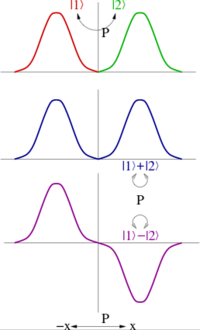User:Physicsyang25/sandbox
Quantum mechanics[edit]
Possible eigenvalues[edit]

In quantum mechanics, spacetime transformations act on quantum states. The parity transformation, , is a unitary operator, in general acting on a state as follows: .
One must then have , since an overall phase is unobservable. The operator , which reverses the parity of a state twice, leaves the spacetime invariant, and so is an internal symmetry which rotates its eigenstates by phases . If is an element of a continuous U(1) symmetry group of phase rotations, then is part of this U(1) and so is also a symmetry. In particular, we can define , which is also a symmetry, and so we can choose to call our parity operator, instead of . Note that and so has eigenvalues . Wave functions with eigenvalue +1 under a parity transformation are even functions, while eigenvalue -1 corresponds to odd functions.[1] However, when no such symmetry group exists, it may be that all parity transformations have some eigenvalues which are phases other than .
For electronic wavefunctions, even states are usually indicated by a subscript g for gerade (German: even) and odd states by a subscript u for ungerade (German: odd). For example, the lowest energy level of the hydrogen molecule ion (H2+) is labelled and the next-closest (higher) energy level is labelled .[2]
The wave functions of a particle moving into an external potential, which is centrosymmetric (potential energy invariant with respect to a space inversion, symmetric to the origin), either remain invariable or change signs: these two possible states are called the even state or odd state of the wave functions.[3]
The law of conservation of parity of particle (not true for the beta decay of nuclei[4]) states that, if an isolated ensemble of particles has a definite parity, then the parity remains invariable in the process of ensemble evolution.
The parity of the states of a particle moving in a spherically symmetric external field is determined by the angular momentum, and the particle state is defined by three quantum numbers: total energy, angular momentum and the projection of angular momentum.[3]
Consequences of parity symmetry[edit]
When parity generates the Abelian group ℤ2, one can always take linear combinations of quantum states such that they are either even or odd under parity (see the figure). Thus the parity of such states is ±1. The parity of a multiparticle state is the product of the parities of each state; in other words parity is a multiplicative quantum number.
In quantum mechanics, Hamiltonians are invariant (symmetric) under a parity transformation if commutes with the Hamiltonian. In non-relativistic quantum mechanics, this happens for any potential which is scalar, i.e., , hence the potential is spherically symmetric. The following facts can be easily proven:
- If and have the same parity, then where is the position operator.
- For a state of orbital angular momentum with z-axis projection , then .
- If , then atomic dipole transitions only occur between states of opposite parity.[5]
- If , then a non-degenerate eigenstate of is also an eigenstate of the parity operator; i.e., a non-degenerate eigenfunction of is either invariant to or is changed in sign by .
Some of the non-degenerate eigenfunctions of are unaffected (invariant) by parity and the others will be merely reversed in sign when the Hamiltonian operator and the parity operator commute:
- ,
where is a constant, the eigenvalue of ,
- .
量子力學[edit]
特徵值[edit]
在量子力學中時空變換是作用在量子態上的。宇稱變換 是一種么正算符,其對量子態的作用如下所示: .
- ^ Levine, Ira N. (1991). Quantum Chemistry (4th ed.). Prentice-Hall. p. 163. ISBN 0-205-12770-3.
- ^ Levine, Ira N. (1991). Quantum Chemistry (4th ed.). Prentice-Hall. p. 355. ISBN 0-205-12770-3.
- ^ a b Andrew, A. V. (2006). "2. Schrödinger equation". Atomic spectroscopy. Introduction of theory to Hyperfine Structure. p. 274. ISBN 978-0-387-25573-6.
- ^ Mladen Georgiev (November 20, 2008). ""Parity non-conservation in β-decay of nuclei: revisiting experiment and theory fifty years after. IV. Parity breaking models"". p. 26. arXiv:0811.3403 [physics.hist-ph].
- ^ Bransden, B. H.; Joachain, C. J. (2003). Physics of Atoms and Molecules (2nd ed.). Prentice Hall. p. 204. ISBN 978-0-582-35692-4.

























![{\displaystyle \left[{\hat {H}},{\hat {P}}\right]=0}](https://wikimedia.org/api/rest_v1/media/math/render/svg/ed981eed8408a73c7ee6e985acf46295e0b30e0f)



